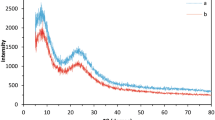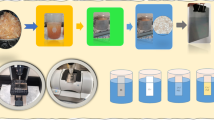Abstract
Coatings tailored to corrosion protection of metallic substrates are of the utmost relevance to ensure reliability and long-term performance of coated parts as well as the product value of the coated materials. Presently, there is a strong emphasis on the development of advanced functional and smart coatings for corrosion protection in different technological applications. This work aimed to develop a novel coating based on chitosan and PVA to evaluate its corrosion inhibition effect on mild steel. Chitosan/PVA films were coated on mild steel by dip coating technique. Sol–gel protective coatings have shown excellent chemical stability, oxidation control and enhanced corrosion resistance for metal substrates. Further, the sol–gel method is an environmentally friendly technique of surface protection which has traditionally been used for increasing corrosion resistance of metals. Films so formed were characterized by Fourier transform infrared spectroscopy (FTIR), X-ray diffraction (XRD), scanning electron microscopy (SEM), the thermal property of the chitosan–PVA film was examined by differential scanning calorimetry (DSC), and thermogravimetric analysis (TGA). Corrosion protection behavior of these coated mild steel substrates in 0.1 N HCl solutions was evaluated by potentiodynamic polarization studies (Tafel), linear polarization studies (LPR), and electrochemical impedance spectroscopy studies (EIS). The experimental results showed that the chitosan/PVA composite coatings were superior to pure chitosan in corrosion protection. EIS measurements and Tafel polarization method have proven that corrosion resistance of mild steel in 0.1 N HCl solutions, increases with increasing the number of layers of chitosan/PVA films. The results indicated that the polymer film adhered to the mild steel surface and inhibited the mild steel corrosion in 0.1 N HCl.









Similar content being viewed by others
References
John S, Joseph B, Aravindakshan KK, Joseph A (2010) Mat Chem phy 122:374–379
Abed Y, Azzar Z, Aounit A, Hammouti B, Kertit S, Mansri A (1999) An electrochemical study of the action of a poly(vinylpyridine) derivative as inhibitor for corrosion of iron in 1 M H2SO4. J Chim Phy 95:1347–1355
Lin Jianguo W, Otieno-Alego V, Schiweinberg DP (1995) Polyvinylpyrrolidone and polyethylenimine as inhibitors for the corrosion of a low carbon steel in phosphoric acid. Corros Sci 7:975–985
Schiweinberg DP, Hope GA, Truemann A, Otieno-Alego V (1996) An electrochemical and SERS study of the action of polyvinylpyrrolidone and polyethylenimine as inhibitors for copper in aerated H2SO4. Corros Sci 38:587–599
Abed Y, Hammouti B, Taleb M, Kertit S, Mansri A (2001) Poly(4‐vinylpyridine) and poly(4‐vinylpyridine poly‐3‐oxide ethylene) as corrosion inhibitors for Cu60‐Zn40 in 0.5 M HNO3. Anti Corros Methods Mater 48:304
Abed Y, Hammouti B, Touhami F, Aounit A, Kertit S, Mansri A, Elkacemi K (2001) Poly (4-vinylpuridine)(P4VP) as corrosion inhibitors of armco iron in molar sulfuric acid solution. Bull Electrochem 17:105–110
Bereket G, Yurt A, Turk H (2003) Inhibition of the corrosion of low carbon steel in acidic solution by selected polyelectrolytes and polymers. Anti Corros Methods Mater 50:422–426
Grchev G, Cvetkovska M, Schultz JW (1991) The electrochemical testing of polyacrylic acid and its derivatives as inhibitors of corrosion. Corros Sci 32:103–112
Kralijie M, Mandie Z, Duie LJ (2003) Inhibition of steel corrosion by polyaniline coatings. Corros Sci 45:181–198
Umoren SA, Ebenso EE, Ogbobe O (2009) Synergistic effect of halide ions and polyethylene glycol on the corrosion inhibition of aluminium in alkaline medium. J Appl Polym Sci 113:3533
Mourya VK, Inamdar NN (2008) Chitosan-modifications and applications: opportunities galore. React Funct Polym 68:1013–1031
Peniche C, Argüelles-Monal W, Goycoolea FM (2008) Monomers, polymers and composites from renewable resources. Elsevier, Amsterdam
Rinaudo M (2006) Chitin and chitosan: properties and applications. Prog Polym Sci 31:603–632
Kumar M (2000) A review of chitin and chitosan applications. React Funct Polym 46:1–27
Berger J, Reist M, Mayer JM, Felt O, Peppas NA, Gurny R (2004) Structure and interactions in covalently and ionically crosslinked chitosan hydrogels for biomedical applications. Eur J Pharm Biopharm 57:19–34
Ghosh B, Urban MW (2009) Self-repairing oxetane-substituted chitosan polyurethane networks. Science 323:1458–1460
Yuan Y, Chesnutt BM, Wright L, Haggard WO, Bumgardner JD (2008) Mechanical property, degradation rate, and bone cell growth of chitosan coated titanium influenced by degree of deacetylation of chitosan. J Biomed Mater Res Part B 86:245–252
Kao W, Wu JY, Chang CC, Chang JS (2009) Cadmium biosorption by polyvinyl alcohol immobilized recombinant Escherichia coli. J Hazard Mater 169:651–658
Khoo KM, Ting Y (2001) Biosorption of gold by immobilized fungal biomass. Biochem Eng J 8:51–59
Brinker CJ, Hurd AJ, Shunrk P (1992) Review of sol-gel thin film formation. J Non-Cryst Solids 147:424–436
Wright JD, Sommerdijk NAJ (2001) Sol-Gel materials chemistry and applications. CRC Press, Florida
Wang D, Bierwagen GP (2009) Sol–gel coatings on metals for corrosion protection. Prog Org Coat 64:327–338
Karthik N, Asha S, Sethuraman MG (2016) Influence of pH-sensitive 4-aminothiophenol on the copper corrosion inhibition of hybrid sol–gel monolayers. J Sol–Gel Sci Technol 78:248–257
Quinet M, Neveu B, Moutarlier V, Audebert P, Ricq L (2007) Corrosion protection of sol–gel coatings doped with an organic corrosion inhibitor: chloranil. Prog Org Coat 58:46–53
Tavandashti NP, Sanjabi S (2010) Corrosion study of hybrid sol–gel coatings containing boehmite nanoparticles loaded with cerium nitrate corrosion inhibitor. Prog Org Coat 69:384–391
Andreatta F, Paussa L, Aldighieri P, Lanzutti A, Raps D, Fedrizzi L (2010) Corrosion behaviour of sol–gel treated and painted AA2024 aluminium alloy. Prog Org Coat 69:133–142
Kim JH, KimJY Lee YM, Kim KY (1992) Properties and swelling characteristics of cross-linked poly (vinyl alcohol)/chitosan blend membrane. J Appl Polym Sci 45:1711–1717
Solmaz R, Kardas G, Culha M, Yazici B, Erbil M (2008) Investigation of adsorption and inhibitive effect of 2-mercaptothiazoline on corrosion of mild steel in hydrochloric acid media. Electrochim Acta 23:5941–5952
Fuchs-Godec R (2006) The adsorption, CMC determination and corrosion inhibition of some N-alkyl quaternary ammonium salts on carbon steel surface in 2 M H2SO4. Colloids Surf A 80:130–139
John S, Joseph A (2012) Effective inhibition of mild steel corrosion in 1 M hydrochloric acid using substituted triazines: an experimental and theoretical study. RSC Adv 2:9944–9951
Vathsala K, Venkatesha TV, Praveen BM, Nayana KO (2010) Electrochemical generation of Zn-chitosan composite coating on mild steel and its corrosion studies. Engineering 2:580
Macdonald R, Franceshetti DR (1987) Impedance Spectroscopy. Wiley, New York
Outirite M, Lagrenee MM, Traisnel M, Jama C, Vezi H, Bentiss F (2010) ac impedance, X-ray photoelectron spectroscopy and density functional theory studies of 3,5-bis(n-pyridyl)-1,2,4-oxadiazoles as efficient corrosion inhibitors for carbon steel surface in hydrochloric acid solution. Electrochim Acta 55:1670–1681
El-Awady AA, Abd-El-Nabey BA, Aziz SG (1992) Kinetic-thermodynamic and adsorption isotherms analyses for the inhibition of the acid corrosion of steel by cyclic and open-chain amines. J Electrochem Soc 139:2149–2154
Ameer MA, Fekry AM (2010) Inhibition effect of newly synthesized heterocyclic organic molecules on corrosion of steel in alkaline medium containing chloride. Int J Hydrogen Energy 35:11387–11396
Ebenso EE, Obot IB, Murulana LC (2010) Quinoline and its derivatives as effective corrosion inhibitors for mild steel in acidic medium. Int J Electrochem Sci 5:1574–1586
John S, Joseph A, Jose AJ, Narayana B (2015) Enhancement of corrosion protection of mild steel by chitosan/ZnO nanoparticle composite membranes. Prog Org Coat 84:28–34
Acknowledgements
One of the authors (S. J.) is very much grateful to University Grant Commission (UGC) for financial support in the form of a minor research project 2390-MRP/15-16/KLMG026/UGC-SWRO.
Author information
Authors and Affiliations
Corresponding author
Rights and permissions
About this article
Cite this article
John, S., Joseph, A., Kuruvilla, M. et al. Inhibition of Mild Steel Corrosion using Chitosan–Polyvinyl Alcohol Nanocomposite Films by Sol–Gel Method: An Environmentally Friendly Approach. J Bio Tribo Corros 3, 3 (2017). https://doi.org/10.1007/s40735-016-0062-z
Received:
Revised:
Accepted:
Published:
DOI: https://doi.org/10.1007/s40735-016-0062-z




